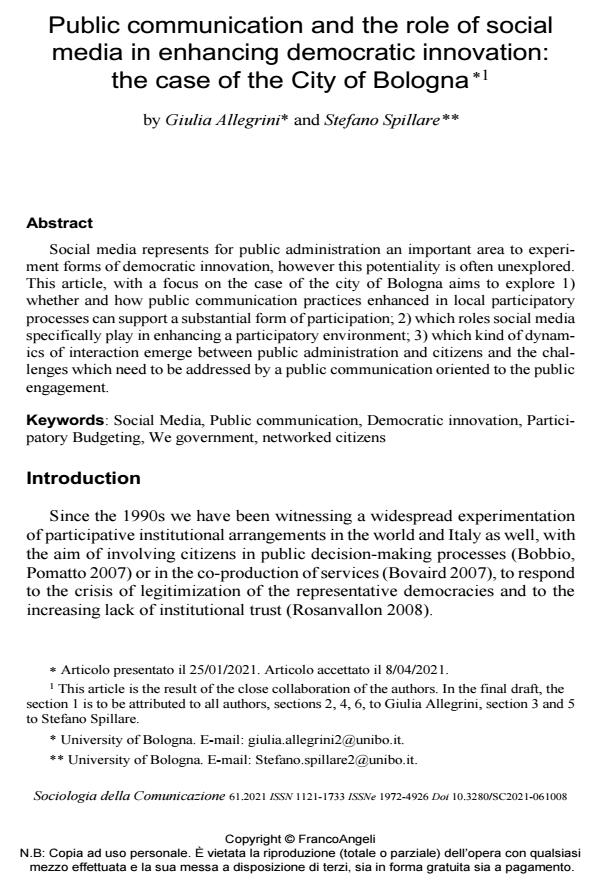Public communication and the role of social media in enhancing democratic innovation: the case of the City of Bologna
Titolo Rivista SOCIOLOGIA DELLA COMUNICAZIONE
Autori/Curatori Giulia Allegrini, Stefano Spillare
Anno di pubblicazione 2021 Fascicolo 2021/61 Lingua Inglese
Numero pagine 18 P. 109-126 Dimensione file 419 KB
DOI 10.3280/SC2021-061008
Il DOI è il codice a barre della proprietà intellettuale: per saperne di più
clicca qui
Qui sotto puoi vedere in anteprima la prima pagina di questo articolo.
Se questo articolo ti interessa, lo puoi acquistare (e scaricare in formato pdf) seguendo le facili indicazioni per acquistare il download credit. Acquista Download Credits per scaricare questo Articolo in formato PDF

FrancoAngeli è membro della Publishers International Linking Association, Inc (PILA)associazione indipendente e non profit per facilitare (attraverso i servizi tecnologici implementati da CrossRef.org) l’accesso degli studiosi ai contenuti digitali nelle pubblicazioni professionali e scientifiche
Social media represents for public administration an important area to experi-ment forms of democratic innovation, however this potentiality is often unex-plored. This article, with a focus on the case of the city of Bologna aims to explore 1) whether and how public communication practices enhanced in local participa-tory processes can support a substantial form of participation; 2) which roles so-cial media specifically play in enhancing a participatory environment; 3) which kind of dynamics of interaction emerge between public administration and citizens and the challenges which need to be addressed by a public communication orient-ed to the public engagement.
Keywords:Social Media, Public communication, Democratic innovation, Partici-patory Budgeting, We government, networked citizens
- Akkerman T., Hajer M., Grin J. (2004), Interactive State. Democratization from Above?, in «Political Studies», vol. 52, pp. 82-95.
- Bartoletti R., Faccioli F. (2016), Public engagement, local policies, and citizens’ participation: an italian case study of civic collaboration, in «Social Media+Society», 2(3), pp. 1-11. DOI: 10.1177/2056305116662187
- Bartoletti R., Faccioli F. (2020), Civic Collaboration and Urban Commons. Citizen’s Voices on a Public Engagement Experience in an Italian City, in «Partecipazione e conflitto», 13(2), pp. 1132-1151.
- Bobbio L., Pomatto G. (2007), Il coinvolgimento dei cittadini nelle scelte pubbliche, in «Meridiana», 58, pp. 45-67.
- Bovaird T. (2007), Beyond Engagement and Participation: User and Community. Coproduction of Public Services, in «Public Administration Review», 67(5), pp. 846-860.
- Carpentier N. (2011), Media and participation: A site of ideological-democratic struggle, Intellect, Bristol, UK.
- Dahlgren P. (2009). Media and political engagement: Citizens, communication, and democracy, Cambridge University Press, New York.
- De Blasio E., Colasanti C., Selva D. (2020), Public Communication and the Barriers to Participation: The Case of Rome from an Open Government Perspective, in «Partecipazione e conflitto», 13(2), pp. 1152-1167.
- De Blasio E., Sorice M. (2016), Innovazione democratica. Un’introduzione, LUISS University Press, Roma, pp. 1-224.
- Donolo C. (1997), L’intelligenza delle istituzioni, Feltrinelli, Milano.
- Ducci G. (2015), Public communication in the Processes of Transparency and Accountability in the Era of Open Data, in «Sociology Study», 5(2), pp. 83-90.
- Ducci G., Materassi L., Solito L. (2020), Re-Connecting Scholars’ Voices. An historical review of public communication in Italy and new challenges in the open government framework, in «Partecipazione e Conflitto», 13(2), pp. 1062-1084.
- Faccioli F. (2013), Comunicazione, sfere pubbliche e processi di civic engagement, in Bartoletti R., Faccioli F. (eds.), Comunicazione e civic engagement, FrancoAngeli, Milano, pp. 174-200.
- Fereday, J., Muir-Cochrane E. (2006), Demonstrating rigor using thematic analysis: A hybrid approach of inductive and deductive coding and theme development, in «International journal of qualitative methods», 5(1), pp.80-92.
- Firmstone J., Coleman S. (2015), Public engagement in local government: the voice and influence of citizens in online communicative spaces, in «Information, Communication & Society», 18(6), pp. 680-695.
- Lathrop D., Ruma L. (2010), Open government: Collaboration, transparency, and participation in practice. O’Reilly Media Inc., Sebastopol (CA, US).
- Linders D. (2012), From e-government to we-government: defying a typology for citizen coproduction in the age of social media, in «Government Information Quarterly», 29, pp. 446-454.
- Lovari A., D’Ambrosi L., Bowen S.A. (2020), Re-Connecting Voices. The (New) Strategic Role of Public Sector Communication After the Covid-19 Crisis, in «Partecipazione e Conflitto», 13(2), pp. 970-989.
- Lovari A., Parisi L. (2012), Public administrations and citizens 2.0: Exploring digital public communication strategies and civic interaction within Italian municipality pages on Facebook, in Comunello F. (ed.), Networked sociability and individualism: Technology for personal and professional relationships, IGI Global, Hershey (Pennsylvania, USA), pp. 238-263. DOI: 10.4018/978-1-61350-338-6
- Lovari, A., Valentini, C. (2020), Public sector communication and social media: Opportunities and limits of current policies, activities, and practice, in Luoma-Aho V., Canel M.J. (eds.), Handbook of Public Sector Communication, Hoboken US: Wiley-Blackwell, pp.315-328.
- Mergel I. (2015), Design social media strategies and policies, in Handbook of Public Administration, Perry J.L., Christensen R.K. (eds.), Jossey-Bass, San Francisco, CA, pp. 456-468.
- Moss, G., Coleman, S. (2014), Deliberative manoeuvres in the digital darkness: E-Democracy policy in the UK, in «The British Journal of Politics and International Relations», 16, pp. 410-427.
- OECD (2001), Citizens as Partners. OECD Handbook on Information, Consultation and Public Participation in Policy-making, [online] available in: http://www.oecd.org.
- OECD (2015). Government at a Glance 2015. Social media use by governments, [online] available in: https://doi.org/10.1787/gov_glance-2015-46-en.
- Paltrinieri R., Allegrini G, (2020), Partecipazione, processi di immaginazione civica e sfera pubblica. I Laboratori di Quartiere e il Bilancio Partecipativo a Bologna, FrancoAngeli, Milano.
- Papadopoulos Y., Warin P. (2007), Are innovative, participatory and deliberative procedures in policy making democratic and effective?, in «European journal of political research», 46(4), pp. 445-472.
- Rosanvallon P. (2008), Counter-democracy: Politics in an age of distrust, Cambridge University Press, Cambridge (UK).
- Zukin C., Keeter S., Andolina M., Jenkins K., Carpini M.X.D. (2006), A new engagement? Political participation, civic life, and the changing American citizen. Oxford University Press, Oxford (UK).
Giulia Allegrini, Stefano Spillare, Public communication and the role of social media in enhancing democratic innovation: the case of the City of Bologna in "SOCIOLOGIA DELLA COMUNICAZIONE " 61/2021, pp 109-126, DOI: 10.3280/SC2021-061008